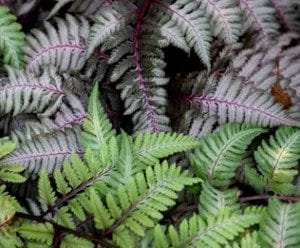Last summer I planted three Japanese painted ferns (Athyrium niponicum ‘Pictum’, Zone 5). I love these plants; their complex form and colouring contribute interesting detail. The ferns emerge olive-green in mid-spring and take on a metallic-grey colour with pink-burgundy veins as the fronds expand. Each plant forms a thick clump with vigorous arching fronds. But all is not well with these lovely ferns. The silver and pink colours are disappearing this spring, and the ferns are becoming solid green.

Green leaves with variegations of white, cream and grey are most often chimeras, spontaneously occurring genetic mistakes in green foliage tissue, resulting in areas of white or cream coloration. The variegation can occur on leaf margins, in zonal patterns on leaves or on stems, and indicates the absence of green chlorophyll. Chlorophyll is a biomolecule essential to the process of photosynthesis, and allows plant tissues to absorb light and convert it to energy. When the chlorophyll content of foliage is decreased by leaf variegation, the entire plant is functioning on less than optimal energy. Some variegated plants have made a secure adjustment and will maintain their varied colour for many years. Others are jeopardized by the loss of energy and may grow slowly. They usually require more sunlight to compensate for their chlorophyll deficit, but are then burnt by too much ultraviolet sun exposure on the lighter tissues.
Plants with variegated foliage, such as ‘Emerald Gaiety’ euonymus and Lamiastrum galeobdolon ‘Herman’s Pride’, usually start out as chimeras on a green plant. The green plant spontaneously develops a branch with attractively variegated foliage, and when noticed by a nurseryman, it’s cut and propagated. Eventually enough plants are available for commerce, and gardeners can purchase variegated specimens. Occasionally an interesting thing happens—the variegated plants recover their ability to produce chlorophyll in the previously white or cream sections of leaves, and produce fully green foliage. You may have noticed this on your own variegated plants, particularly variegated euonymus which frequently reverts to fully green leaves. To maintain the variegated leaves, you must cut out the solid green growth whenever it appears.
Not all variegated plants are the result of genetic accidents. The bold cream and silver markings on Cyclamen hederafolium leaves are caused by air under the epidermis, lifting the surface tissues and creating a silvery reflection of light patterns. Some hosta, clover and oxalis species have cream markings that are consistently present; while others, like coleus, have diverse colour markings that are stable and can be reliably propagated from seed.
My Japanese painted ferns are making a strong bid to recover their chlorophyll-making ability, which is to say they are rapidly turning green. I’m glad to know they’re repairing their broken genetic tracks and able to manufacture more energy, but I liked them better when they were weakand beautiful.

‘Canary Bird’: a special rose
The long history of rose hybridizing has brought thousands of gorgeous roses into commerce. All can trace their lineage to wild plants, and after decades (and in some cases, centuries) of mixing genes, they have evolved into roses with complex genealogies. Popular modern roses like the deeply scented apricot shrub ‘Westerland’, started with the species Rosa polyantha and eventually had 108 genetic contributors before being introduced in 1969 as a named cultivar.
Not all roses need such a long breeding history to achieve beautiful form and colour. One of my favourite roses is ‘Canary Bird’ (Zone 6; Zone 5 with winter protection), reputedly a light yellow sport of the old Chinese species Rosa xanthina. A sport is a naturally occuring hybrid or genetic accident, probably resulting from a chance crossing of genes with another species. ‘Canary Bird’ may have resulted from R. xanthina crossing with R. hugonis, or with R. pimpinellifolia. Because the blending of genes took place in the wild, ‘Canary Bird’ can’t be pinned down to a verifiable pedigree. It’s a beautiful rose that blooms in mid-May, a month before other roses, harmoniously coinciding with lilacs and forget-me-nots in my garden.
‘Canary Bird’ has long, slender canes with warm brown bark and very few thorns (carried at the bottom end of the canes). It grows to about 6 feet (2 m) tall and wide, and the vigorous arching canes are covered in elegant buds that open to five-petaled yellow flowers, two to three inches (5 to 8 cm) across, with a boss of golden stamens in the centre. The flowers are freshly scented and surrounded with small, light green foliage. It’s a delightful plant in late spring and maintains an airy and open form through the growing season. ‘Canary Bird’ has been completely healthy in my Zone 6 garden and I never give it winter protection, although it probably would need protection if grown in Zone 5.
I’ve had my ‘Canary Bird’ shrub for about six years, and recently tried to find another, but with no success. It’s still sold in Britain, and perhaps will be offered again in Canada, particularly if we ask rose suppliers to stock it.
Thanks for visiting Making a Garden, and I’ll see you again next week.
